Fine acting enables FSW’s ‘She Kills Monsters’ transcend Dungeons and Dragons theme
 There remain only three more performances of FSW’s production of Qui Nguyen’s fantasy romp, She Kills Monsters. I regret not having seen the show until last night or getting this out sooner. It’s a show worth seeing if,
There remain only three more performances of FSW’s production of Qui Nguyen’s fantasy romp, She Kills Monsters. I regret not having seen the show until last night or getting this out sooner. It’s a show worth seeing if, 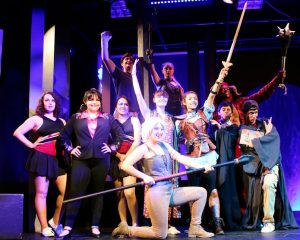 for no other reason, than the strong performances turned in by Kiana Pinder, Gabrielle Lansden, Jorge Luis Cabal, Kenny Larmar, Courtney Sander and Faith Deterding. But thematically, She Kills Monsters has much to say about the opportunities most of us miss to truly get to know the family and friends who populate our lives.
for no other reason, than the strong performances turned in by Kiana Pinder, Gabrielle Lansden, Jorge Luis Cabal, Kenny Larmar, Courtney Sander and Faith Deterding. But thematically, She Kills Monsters has much to say about the opportunities most of us miss to truly get to know the family and friends who populate our lives.
Admittedly, the package that playwright Qui Nguyen uses 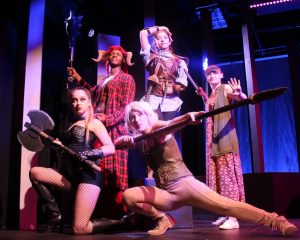 to deliver this message can be a little off-putting to Boomers and Millennials as the storyline takes the cast and audience alike squarely into that bastion of nerdland roll-playing known as Dungeons and Dragons. If you’re not familiar with the plot, She Kills Monsters tells the story of Agnes Evans, an oh-so-straight-laced twenty-something high school teacher who is trying to come to terms with the death of her younger sister, Tilly, who loved to
to deliver this message can be a little off-putting to Boomers and Millennials as the storyline takes the cast and audience alike squarely into that bastion of nerdland roll-playing known as Dungeons and Dragons. If you’re not familiar with the plot, She Kills Monsters tells the story of Agnes Evans, an oh-so-straight-laced twenty-something high school teacher who is trying to come to terms with the death of her younger sister, Tilly, who loved to 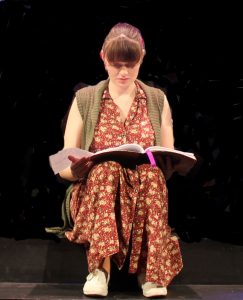 play the game. In fact, Tilly was so adept at it that she became something of a local legend. But none of this is known to Agnes until she comes across a notebook containing a gaming scenario while packing up Tilly’s things. In an effort to get to know her sister posthumously – and gain some closure in the process – Agnes enlists the help of a dungeon master to escort her through the module Tilly left behind.
play the game. In fact, Tilly was so adept at it that she became something of a local legend. But none of this is known to Agnes until she comes across a notebook containing a gaming scenario while packing up Tilly’s things. In an effort to get to know her sister posthumously – and gain some closure in the process – Agnes enlists the help of a dungeon master to escort her through the module Tilly left behind.
To be sure, Nguyen wrote She Kills Monsters in 1995, but there’s no need for apologies today in structuring a storyline or characters that make use of D&D. After all, Dungeons and Dragons is a recurring reference (if not subplot) in numerous Big Bang Theory episodes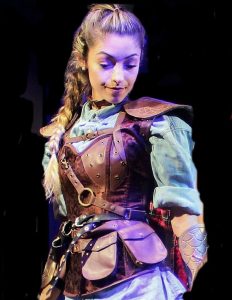 (one of which drew 14 million viewers). But that ode to geekdom aside, it turns out that D&D is enjoying something of a Renaissance, with A-List celebs like Vin Diesel, Dwayne Johnson and Drew Barrymore copping to their infatuation with the roll-playing vignettes. (So do Stephen Colbert, Mike Myers and Cooper Anderson, but most people would be surprised if they didn’t play D&D.)
(one of which drew 14 million viewers). But that ode to geekdom aside, it turns out that D&D is enjoying something of a Renaissance, with A-List celebs like Vin Diesel, Dwayne Johnson and Drew Barrymore copping to their infatuation with the roll-playing vignettes. (So do Stephen Colbert, Mike Myers and Cooper Anderson, but most people would be surprised if they didn’t play D&D.)
“Therapists use D. & D to get troubled kids to talk about experiences that might otherwise embarrass them, and children with autism use the game to improve their social skills,” notes Neima Jahromi writing for New Yorker magazine in October of 2017. 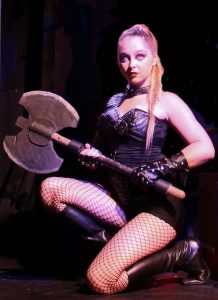 “Last year, researchers found that a group of a hundred and twenty-seven role players exhibited above-average levels of empathy, and a Brazilian study from 2013 showed that role-playing classes were an extremely effective way to teach cellular biology to medical undergraduates.”
“Last year, researchers found that a group of a hundred and twenty-seven role players exhibited above-average levels of empathy, and a Brazilian study from 2013 showed that role-playing classes were an extremely effective way to teach cellular biology to medical undergraduates.”
Still, Dungeons and Dragons is merely a pretext that provides Agnes a portal into her sister’s world and underlying psyche, which comes to a head when Agnes happens upon her sister sharing a kiss with her D&D bestie, the Demon Queen Lilith (who is reminiscent of the nocturnal demoness by the same name who haunts the destroyed Kingdom of Edom). Agnes’ reaction is strong and strident. But it’s not because she’s a homophobe. 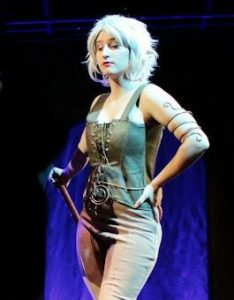 It’s a combination of guilt, remorse and anger that not only did she not know about her sister’s gender orientation while Tilly was still alive, but that she had to discover it in a game like D&D.
It’s a combination of guilt, remorse and anger that not only did she not know about her sister’s gender orientation while Tilly was still alive, but that she had to discover it in a game like D&D.
And therein resides the truly powerful message underlying She Kills Monsters. All of us engage in role-playing in our everyday lives. We conform to paradigms imposed by society and strive to meet the expectations that our parents, children, spouses, employers and teachers have regarding how we should think, act and behave. Conversely, we’re just as willing to accept at face value the facades that others present to us in their ongoing efforts to meet the 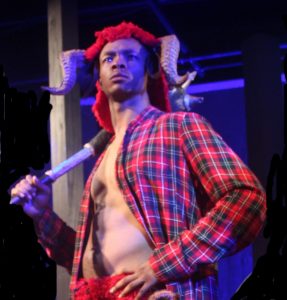 expectations we impose on them in return. Like Agnes, we’re all so busy and self-absorbed that it is far easier and much less time-consuming to deal with people superficially – or not at all.
expectations we impose on them in return. Like Agnes, we’re all so busy and self-absorbed that it is far easier and much less time-consuming to deal with people superficially – or not at all.
She Kills Monsters is no Doll’s House, and it would be completely understandable for a message as abstruse as this to get lost in the flashy swordplay and abundant stage combat taking place on the minimalist Black Box set. But thanks to Stuart Brown’s careful direction, enlightened staging and exceptionally good acting, 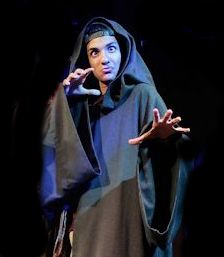 the denouement is as satisfying as it is believable.
the denouement is as satisfying as it is believable.
Faith Deterding and Courtney Sander are pure awesome in the roles of the Elven Kaliope and devilishly oversexed Lilith. They take posturing and primping to Olympian levels, but it is with her tender portrayal of Lilith’s real-world alter ego, an introspectively conflicted high school student by the name of Lilly (who shared her first same sex kiss with real-world Tilly) that Sander provides a glimpse of her vast thespian upside. The girl can act.
And so can Jorge Luis Cabal and Kenny Larmar.
Cabal is dungeon master Chuck, who threatens to steal each scene in which he appears. He wins over the audience from his very first appearance. Plus he’s just fun to watch as he lurks beneath a deep-set Obi Wan hoodie to direct the D&D action like a master puppeteer. He’s at his best as he crushes on Agnes, who’s forbidden fruit on the order of that apple in the Garden of Eden. Based on his performance as Chuck, though, Cabal should attract bigger and even better roles as he continues to develop his stagecraft.
As the Overlord of the Underworld, Larmar’s Orcus is indeed an imposing figure – aglow in washboard abs, furry red Centaur legs and cloven feet. But in his own realm, he’s as conflicted as Lilly, except at the crux of Orcus’ dissatisfaction is his preference to while away the days watching ‘80s and ‘90s sitcoms and dramas (he has a mancrush on ER’s George Clooney) rather than stealing souls. Larmar does a good job of shifting back and forth between his officious persona and couch-potato inclinations, changing his vocal tone and inflections to underscore each transition.
Chloe Chan and Brithany Hernandez excel as Evil Tina and Evil Gabbi, a pair of duplicitous cheerleaders on a par with those legendary Heathers. This dynamic duo were such bullies in real life that Tilly re-created them in New Landia as unbeatable foes. Their ultimate come-uppance in their penultimate dance-off as a result of Tilly and Agnes’ treachery drew enthusiastic applause from everyone in the audience who’s ever found themselves on the receiving end of condescension from the cool and chic, especially those of us who grew up geek and nerd.
In the final analysis, this is a play about two sisters, and Gabrielle Lansden and Kiana Pinder acquit themselves with both power and finesse as Agnes and Tilly. Lansden shows tremendous versatility as the stranger reluctantly venturing into a strange new land. Her initial encounters with Lilith and Kaliope are downright hysterical, particularly her reaction to Lilith’s skimpy Dominatrix costume, fishnet stockings and imposing black boots. She’s rewarded for her priggishness by being dubbed Agnes the Asshatter, but alas, she learns to unclench by the end of the show. Still, look up the word incredulity on Google, and chances are you’ll find a photo of Lansden playing Agnes in New Landia’s Enchanted Forest.
Pinder’s is the performance that binds both the action and the actors together with the strength of Gorilla glue. It’s easy to appreciate that she’s the dancer in the troupe, and her training as such clearly advances the choreography and blocking in the show. But more, Pinder is so winsome as the vulnerable Tilly that she tugs continually at the audience’s heartstrings, not to mention those of her big sister, Agnes, who only learns how special she was in the afterworld – but better than never at all.
This is an entertaining show worth seeing. Follow the links provided below for more information, including remaining play dates, times and ticket information.
April 6, 2018.
RELATED POSTS.














 Tom Hall is both an amateur artist and aspiring novelist who writes art quest thrillers. He is in the final stages of completing his debut novel titled "Art Detective," a story that fictionalizes the discovery of the fabled billion-dollar Impressionist collection of Parisian art dealer Josse Bernheim-Jeune, thought by many to have perished during World War II when the collection's hiding place, Castle de Rastignac in southern France, was destroyed by the Wehrmacht in reprisal for attacks made by members of the Resistance operating in the area. A former tax attorney, Tom holds a bachelor's degree as well as both a juris doctorate and masters of laws in taxation from the University of Florida. Tom lives in Estero, Florida with his fiancee, Connie, and their four cats.
Tom Hall is both an amateur artist and aspiring novelist who writes art quest thrillers. He is in the final stages of completing his debut novel titled "Art Detective," a story that fictionalizes the discovery of the fabled billion-dollar Impressionist collection of Parisian art dealer Josse Bernheim-Jeune, thought by many to have perished during World War II when the collection's hiding place, Castle de Rastignac in southern France, was destroyed by the Wehrmacht in reprisal for attacks made by members of the Resistance operating in the area. A former tax attorney, Tom holds a bachelor's degree as well as both a juris doctorate and masters of laws in taxation from the University of Florida. Tom lives in Estero, Florida with his fiancee, Connie, and their four cats.